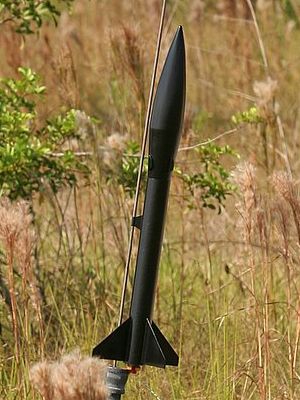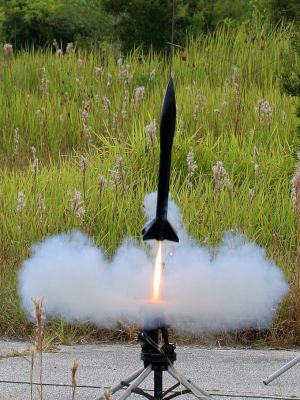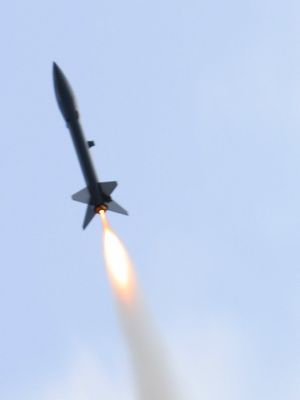| Construction Rating: | starstarstarstarstar_border |
| Flight Rating: | starstarstarstarstar_border |
| Overall Rating: | starstarstarstarstar_border |
| Manufacturer: | Madcow Rocketry  |
Brief:
Madcow Rocketry's Honest John Basic Style 31 is a premium priced mid power
rocket kit. If you are looking for an excellent scale Honest John kit at any
price, then look no further.
Construction:
Madcow obviously lives by the "you get what you pay for" saying
because from the moment the box arrived, it shows that they want to produce
some seriously high quality kits. The kit arrived comfortably and generously
packed in foam peanuts. The kit itself was sealed in heavy gauge clear plastic
with many of the smaller components sealed in smaller bags and the large
two-piece balsa nose cone bundled inside of a paper wrapper. The body tubes
were laser cut to the proper lengths as well as laser cut slots in the
main body tube. The most amazing aspects of the kit were:
- The precision, quality, and attention to detail of all the components and instructions
- The overall light weight of the kit
- No (mechanical) motor retention included**
** -- Personally, using friction fit retention is an acceptable motor retention method/technique to me. However, I'm sure that other builders might be less than impressed with the kit's offering here. I can understand this potential gripe as it is surprising to find a kit that is so completely thorough in every other aspect as this one, not to mention when you factor in the kit's cost.
Specifically, here is what was in the packaging:
- Two-piece balsa nose cone
- 1 pre-slotted (laser cut) 1.9" diameter body tube
- 2 laser cut 1/8" thick light plywood centering rings
- 1 29mm motor tube
- 4 laser cut 1/8" thick light plywood fins
- Nose cone coupler, bulkhead, eyebolt, washer, and nut
- Kevlar® shock cord
- Nomex® heat shield
- 18" Top Flite chute
- 2 1/4" launch lugs with mounting spacers
- 4 balsa nose cone detail pieces
- 1 decal
- 1 six page instruction manual
Believe it or not, I really do read through the instructions before starting to build a new kit. Madcow scored some serious points in my book by having a level of detail that made it quickly apparent that their kits would definitely make them a very good recommendation for someone looking to get into mid power rockets.
Over 6 steps, I was carefully guided through the build and left with no questions as to how and when the parts should be joined together. This was no more obvious when in Step 1 I was instructed to mark the motor tube 1/2" from the aft end and place the centering ring with the line on the forward edge of the CR. I mean how many times have you built a MPR or HPR kit and wondered if the CRs should be forward, aft or right on the mark?! If anything (and if it's even possible), Madcow takes it a little too far by saying that the CRs should be an uncommon 3.35" apart. That's a slight problem as most rulers are graduated in 1/16ths of an inch. (5/16 = 0.3125 and 3/8 = .375) All is forgiven though when in large bold print it tells you to test fit the fins between the centering rings.
Other than that minor issue, the assembly went without any problems thanks to the explicit instructions and well fitting components. Also, anyone who has built a kit with laser cut parts knows that everything fits like it ought to. There is no exception here.
5-minute epoxy is recommended throughout the entire build although aliphaetic resin (yellow wood glue) should work at least as well for the attachment and fillets of all wood and paper parts except for attaching the Kevlar® shock cord to the motor tube and securing the eyebolt to the bulkhead. I went the route of using Elmer's ProBond for the bulk of construction while breaking out the epoxy only when really needed as previously mentioned.
While I certainly appreciated the precise fin slots, I have to admit that slotting a body tube is arguably my favorite part of building a rocket that has through the wall fins. I suppose having to put in the effort of slotting the tube myself makes me feel like I am building a kit instead of just assembling one. That said, the folks who aren't so keen on cutting slots will reap the benefits of such well made openings. And no mention is made in the instructions as far as whether the leading and/or trailing edges of the fins should be rounded or bevelled so I simply opted to leave the edges square.
The most unusual part of this build is putting the nose cone together. There are 2 large balsa pieces--and I should add that the balsa is quite dense and hard--that join end to end to form the telltale feature of the Honest John. This step could be quite messy if done with epoxy but I used the double glue method and a wrap of masking tape to keep both balsa pieces lined up until dry. A noticeable seam was left behind to fill although the parts matched up wonderfully. Then there are the 4 balsa façade pieces that are glued onto the nose cone. Be sure when getting ready to glue these pieces on that they all have the same shape--they are uncannily similar in size/shape to the 2 launch lug standoffs. While the builder must mark the lines on the base of the nose cone for attaching the façades, I chose to accomplish this by extending the lines of the fin slots along the tube and onto the nose cone to ensure that everything would line up.
Perhaps the biggest surprise is that there is no mechanical form of motor retention included with the kit. While there isn't a lot of room for blind nuts, anyone with a little creative ingenuity could come up with a way to hold their motors in place with a clip. I, however, am quite comfortable with using friction fit for motor retention and left the rocket as is. Another surprise (albeit noticeably less) missing item is a 24mm motor adapter. With a finished weight of 10oz (give or take an ounce), using a 24mm E or F is well within the capabilities those motors to produce a safe flight with this kit.
Finishing:
With such a sizeable balsa nose cone, lots of filling and sanding is in order.
Slightly diluted Elmer's Wood Filler (or Fill 'n' Finish) makes this as
effortless as sanding and filling could ever be. Once satisfied with the shape
and smoothness of the nose cone, I laid down a couple coats of Krylon primer
and wet sanded the entire rocket down with 400 grit sandpaper. Next, I kept the
paint scheme simple and went with Krylon gloss black. I went with gloss black
instead of flat or matte black because of the shiny decal. Speaking of the
decal, it is listed on the Madcow website and instructions as vinyl, however,
it was not a vinyl decal like what I've used on BSD Rocketry and Binder Design
kits--but was a peel 'n' stick decal with a clear, glossy finish. I trimmed
around the edges of the white "U.S. ARMY" decals to minimize the
(negative) visual impact of the glossy decal.
Construction Rating: 4 out of 5
Flight:
Both flights were made on the same day with the same motor, F40-7W reloads for
the AT 29/40-120 hobby RMS hardware. The weather was a sweltering 90 degrees
with just an oocasional mild breeze.
Packing the recovery hardware was fairly non-eventful as there was adequate room for packing the Nomex® heat shield, chute, and shock cord. A couple well-placed wraps of masking tape were enough to hold the motor securely. I did use a Quickburst Twiggy in place of the included AT Copperhead ignitor.
Both flights were virtually identical most of the way up. The F40s lit without hesitation and quickly vaulted the Honest John skyward. I was quite impressed with the rocket's velocity and altitude considering the overall modest impulse of that reload.
Based on these flights, The Honest John should be capable of comfortably safe flights on popular 24mm E and F motors with an appropriate motor adapter.
Recovery:
The Honest John has a bit of a rough ride on the way down for both flights.
The first flight's problem can be purely attributed to my error. I packed the chute on top of the Nomex® heat shield instead of inside it (commonly referred to as the "burrito method"). Ejection gases pushed their way around the heat shield, and burned about a 3" diameter hole in the side of the chute.
The second flight was an issue of a less than desirable short delay. This cause ejection while the rocket was still on the way up. That leads to a simple equation: velocity + large balsa nose cone = notable damage. The nose cone collided with one of the fins, which left a sizeable notch in the nose cone and popped a fin loose. To make matters worse, it landed on a nearby road, putting a little rash on the nose cone and the tips of a couple fins. That kind of stuff just comes with the hobby, and I cannot count these issues as faults of the kit. In fact, I had several folks in attendance make overwhelmingly positive comments about both flights and the good looks of the rocket.
Flight Rating: 4 out of 5
Summary:
The Madcow Honest John is without a doubt the most thorough kit straight out of
the box that I have ever built, however, you should get such quality components
and instructions for the comparatively high cost of the kit! And while some are
likely to question the lack of mechanical motor retention, I'd personally only
fault the manufacturer for just leaving out a 24mm motor adapter as the
lightweight but certainly robust Honest John could certainly fly on those
motors. In the end, you get a really sweet kit that is well designed, has some
of the finest components I have ever seen in any kit of any size, and flies
very well. There is plenty of truth in the old cliché "you get what
you pay for".
PROs:
- Some of the highest quality components I have seen in a kit from any manufacturer.
- Excellent instructions make this kit easy to recommend to folks wanting to get into mid power kits.
- Lightweight design allows the rocket to be flown on a wide range of motors.
- Laser cut components ensure the proper fit of all components with nearly zero sanding.
CONs:
- Some folks might want a mechanical form of motor retention.
- Such great quality doesn't come cheap.
- Glossy peel 'n' stick decal doesn't look so good on flat paint scheme.
- No 24mm motor adapter included.
Overall Rating: 4 out of 5
 |
 |
Flights
Date | Flyer | Rocket | Altitude |
|---|---|---|---|
2006-10-21 | Lance Alligood | Madcow Rocketry HoJo 31 | - |
2006-10-21 | Lance Alligood | Madcow Rocketry HoJo 31 | - |
 |
 |
Sponsored Ads
 |
 |

















M.J.T. (August 17, 2008)